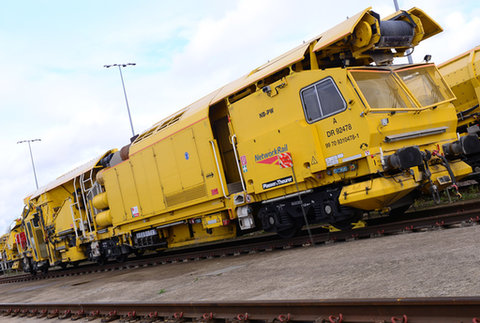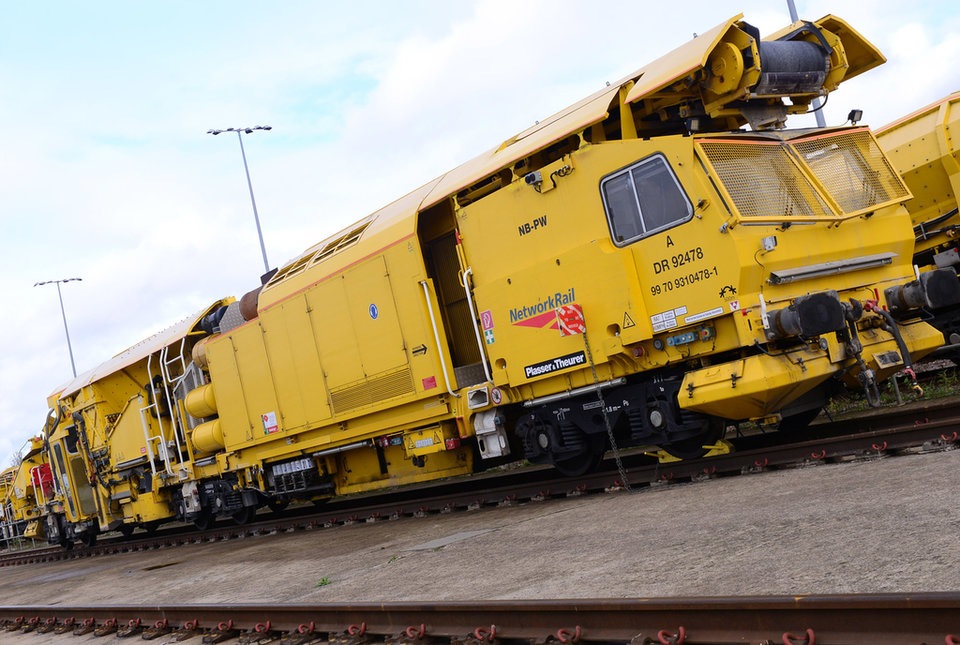All images: Max Bögl
Technology
Q&A: recovering stranded railway vehicles with HBC Radiomatic
UK-based radio systems manufacturer HBC Radiomatic has recently developed a new solution for Network Rail that facilitates the recovery of stranded railway vehicles. Frankie Youd speaks to HBC Radiomatic technical sales manager Mark Hollyhead about the new technology, and what unique benefits the remote-control unit will provide.
The maintenance vehicles operating along the Network Rail track, such as ballast cleaners, can be over half a mile long. If they break down and get stranded on site, they can cause major issues by blocking the line, delaying or cancelling passenger journeys, and causing rail network disruption.
The machines run by Network Rail are programmable logical controller (PLC) systems, which would require specialist equipment to be brought out to rescue the stranded machines, if they malfunction. Network Rail needed a solution that could be operated remotely to assist their recovery.
While the machines becoming stranded is a rare occurrence, being able to safely recover and move them is important for the industry. Network Rail acknowledged that it would require lightweight, but robust, equipment that employees could easily carry and use in all weather conditions.
Network Rail contacted HBC Radiomatic UK to manufacture a solution to fit its remote-control requirements. HBC Radiomatic addressed the brief by creating remote control transmitters in the form of a lightweight and portable remotely controlled system that can recover stranded railway vehicles in a safe, controlled manner.
Mark Hollyhead explains the key benefits of the remote-control unit as well as how the technology can access the stranded machines remotely.

Aerial view of the derailment. Image: UK Government
Mark Hollyhead. Credit: HBC Radiomatic.

Frankie Youd: Could you tell me about the history of Radiomatic UK?
Mark Hollyhead: HBC Radiomatic is a German product, it has been manufactured in Germany for 75 years, from a family-owned company.
HBC Radiomatic UK are the UK agents for them, we are based in Birmingham. HBC Radiomatic UK was established in 2011. We manufacture, provide installation, repair, and carry out services on HBC Radiomatic products.
When things did start to pick up, when the lockdown was relaxed, the trains were fantastic
Could you explain how the remote-controlled technology works?
The brief for this project was that Network Rail’s maintenance systems use PLC control. If that fails, they can't move the trains. If the train is stopped there because of electrical failure, then it's going to hold up passenger trains.
The brief was to design a system in conjunction with Network Rail that could manually recover these systems. We designed a radio system, which was our 737 spectrum-3, and a small control panel for them. So, in the event of a failure, it's got to be a very lightweight piece of equipment because you're asking people to physically carry it.
The receiver part of the equipment fits onto the side of the train with magnets, and then there are these cables that they can physically plug into the train to move it. Because it's radio-controlled, they can step away from the train, away from the danger area, and just control it with our radio control. The alternative that they had in place before was to physically get underneath the train and do it manually, which is not a very safe option.
We've sold it to Network Rail and demonstrated it to their employees who then go and form a training package for the employees who are going to use it.
What are the main benefits of using a remote-controlled unit?
For the operator to be able to work safely. That's the idea of any radio control system, it also increases efficiency, but the main benefit of radio control is safety.
We will use 2.4GHz technology for the frequency, which is an adaptive intelligent frequency system, so it's never going to get interrupted so the operators can work problem-free. The main unit, that fits onto the side of the train, weighs 7.5kg. The actual part that they hold in their hands is about 3kg, and that fits around the waist, so there is no weight on the operator at all.
All of our radio equipment meets all the relevant safety standards, machinery safety is very important these days. All our radio systems meet the standards to be safely used on the machinery.

Image: MaxBögl
What causes railway maintenance vehicles to become stranded?
It's because of the electrical system on the train; there's a possibility that the electrical system on the train can fail. This is a very infrequent problem for Network Rail, but, if it does happen, it’s a major problem for them because you have a train stuck on the track, which can cause delays.
The radio kit that we've supplied is very much a worst-case scenario, which might sit on the train for years and never get used, but it’s there just in case.
Can technology such as this be adapted for different uses within the industry?
Anything that's controlled electrically can be controlled by a radio control system. So, this could be adapted to all sectors of industry. We are always looking for new applications, it's a very competitive market so everybody's looking for niche markets to try and find new applications.
You generally see this technology used on cranes, hydraulic machines for lifting, basically anything that's controlled electrically. Sometimes it makes sense to use it, sometimes it just doesn't.
Is the company working on any future projects?
It’s very much a case that somebody has to come to us with an application, and then you have to design the system to suit and carry out that application. You could spend a lot of time developing something for a system that doesn't make sense because the guy might say it’s much safer to drive it from the cab himself.
We're very dependent on people approaching us and saying that they they think radio control could work for this. Then we can sit down with the application and design something to work for it.
A Network Rail recovery vehicle, fitted with HBC Radiomatic technology. Credit: HBC Radiomatic.